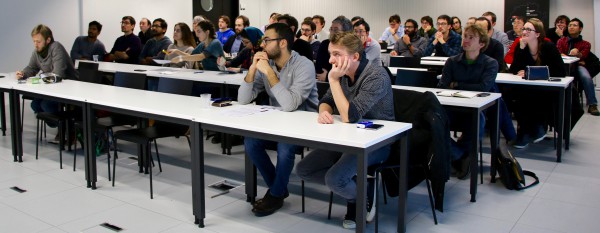MARVEL Junior Seminar — November 2025

Each seminar consists of two presentations of 25 minutes each, allowing to present on a scientific question in depth, followed by time for discussion. The discussion is facilitated and timed by the chair.
Pizzas will be served after the seminars in order to facilitate discussions based on the talks just presented.
Onsite participation
12:15 — Seminars take place in EPFL room Coviz2 (MED 2 1124)
~13:15 — Pizzas will be served in the MED building atrium, second floor
Online participation
Starting at 12:15:
https://epfl.zoom.us/j/64058301878
Password: 829399

Abstracts
Talk 1 — Algorithmic Differentiation for plane-wave DFT: materials design, error control and learning model parameters
Niklas Schmitz, Bruno Ploumhans, Michael Herbst
Mathematics for materials modelling (MatMat), EPFL
We present a differentiation framework for plane-wave density-functional theory (DFT) that combines the strengths of forward-mode algorithmic differentiation (AD) and density-functional perturbation theory (DFPT) [1]. In the resulting AD-DFPT framework derivatives of any DFT output quantity with respect to any input parameter (e.g. geometry, density functional or pseudopotential) can be computed accurately without deriving gradient expressions by hand. We implement AD-DFPT into the Density-Functional ToolKit (DFTK) and show its broad applicability. Amongst others we consider the inverse design of a semiconductor band gap, the learning of exchange-correlation functional parameters, or the propagation of DFT parameter uncertainties to relaxed structures. These examples demonstrate a number of promising research avenues opened by gradient-driven workflows in first-principles materials modeling.
[1] https://arxiv.org/abs/2509.07785
Talk 2 — Towards understanding the anionic redox activity in layered Na-ion battery cathode materials
Valentina Sanella, Iurii Timrov, Claude Ederer
Materials Theory, ETH
The global shift toward renewable energy demands efficient, sustainable, and affordable energy storage technologies. Lithium-ion batteries currently dominate the market, but their reliance on scarce and expensive raw materials raises concerns about long-term cost and sustainability. Sodium-ion batteries (NIBs) have emerged as a promising alternative, benefiting from the abundance and low cost of sodium while offering comparable electrochemical principles. However, their large-scale deployment is still limited by the moderate performance and structural instability of cathode materials.
Among the available candidates, layered manganese-based oxides (NaxMn1-yMyO2) stand out for their cost-effectiveness, environmental friendliness, and structural versatility. Yet, their electrochemical behavior remains poorly understood, particularly regarding the interplay between cationic and anionic redox processes.
First-principles simulations based on density-functional theory (DFT) with self-consistent Hubbard corrections (DFT+U+V) reveal how the sodium concentration and local Mn environment influence the electronic structure and Jahn-Teller activity of P2-type NMO. Simulated X-ray absorption (XAS) and resonant inelastic X-ray scattering (RIXS) spectra establish a direct link to experiment, clarifying the contributions of both Mn and O to the overall redox mechanism.
These insights provide a microscopic understanding of Mn-based layered cathodes and outline design principles to enhance stability, reversibility, and sustainability of next-generation NIBs.
Check the list of the next MARVEL Junior Seminars here.
Low-volume newsletters, targeted to the scientific and industrial communities.
Subscribe to our newsletter